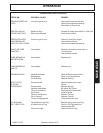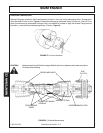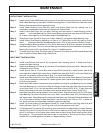
Maintenance Section 5-7
MAINTENANCE
LJ60/72 02-02
© 2004 Alamo Group Inc.
MAINTENANCE
BLADE CARRIER REMOVAL/INSTALLATION
Move cutter and tractor to a solid level surface (concrete slab of pavement). Raise cutter approximately 12" and
securely block at this height. Remove blades before removing carrier to maintain carrier balance. To remove the
blade carrier, loosen (DO NOT REMOVE) the six bolts retaining the carrier to the carrier hub. Place a floor jack
under cutter and lift carrier on center line between bolts to support carrier. Remove blade carrier bolts at this point.
Lower jack with carrier and remove from under cutter deck. Reverse process to install carrier.
BLADE CARRIER HUB REMOVAL/INSTALLATION
To ensure safety, the blade carrier must be removed from the carrier hub, as described above, before removing the
carrier hub from the gearbox output shaft. To remove the carrier hub, remove cotter pin and nut from gearbox output
shaft. Using a suitable 2-jaw gear puller, pull hub off tapered gear box shaft.
To install the blade carrier hub, clean the splines on both the blade carrier and output shaft. Position the hub on the
gearbox output shaft and install special washer nut. Tighten nut holding carrier hub while striking the hub several
times with a heavy hammer to seat the hub onto the output shaft. Use a suitable spacer over the nut to prevent
damage to the nut and threads. Retighten the nut to a minimum of 450 ft. pounds. Install cotter pin and spread.
IMPORTANT: Always recheck gearbox output shaft and blade carrier to be sure they are retaining nut torque after
a few hours operation.
BLADE REMOVAL/INSTALLATION
To remove blades for sharpening or replacement, remove the cover plate on deck of
cutter near gear box. Remove lock nut from blade bolt. NOTE: Inspect lock nut
after removal and replace if threads are damaged. Always replace nut when
replacing blade bolt. When installing blades be sure and check blade bolt pivot
diameter for wear. Replace bolt if worn more than 1/4 inch at any point. See
Figure 12. Install blade bolts with partially worn side of bolt either toward or away
from center. Tighten lock nut to 400 ft. lbs.
WARNING! Avoid personal injury. Blade and/or blade carrier removal should be done only with the
tractor engine shut off, key removed, in neutral, parking brake on , PTO disengaged, and
the cutter blocked in the raised position. Never work under the cutter with support blocks to
keep the frame from falling.
1/4"
FIGURE 12
SLIP CLUTCH
A slip clutch is incorporated in the PTO driveline. It is designed to slip, absorb the shock load, and protect the
driveline.
After the first hour of operation, the slip clutch should be checked for overheating. After this first check, the slip
clutch should be checked weekly or anytime there is overheating. To adjust the coil spring slip clutch, tighten the
spring bolts 1/8 (maximum) turn at a time. Bolts should NEVER be adjusted to the point where the coil springs are
compressed solid. Minimum spring compression length is 1-7/16".
The slip clutch should be checked periodically and adjusted to compensate for wear. The lining plates are 1/8"
thick when new. Replace after 1/32" wear. If the mower has been idle for an extended period of time, or in wet
weather, before operating check to be sure the friction lining plates are not rusted/coroded together. Should this
occur refer to the procedure described in the "Seasonal Clutch Maintenance" section on the next page.


















